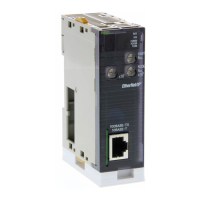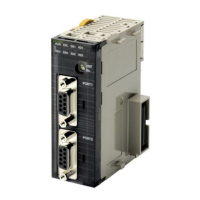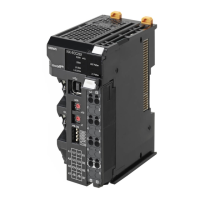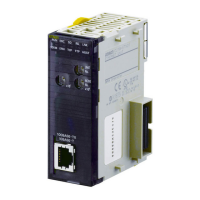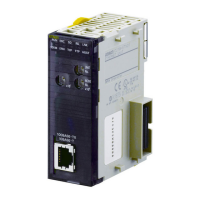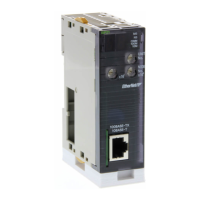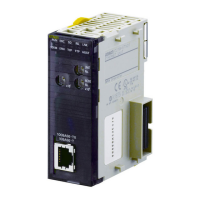282
Auxiliary Area and CIO Area Allocations (Modbus-RTU Slave Mode) Section 9-3
Note 1. The settings in the Setup Area are reflected here. The default settings will
be used and will be stored here if a setup error occurs.
2. Always 1 (1 stop bit) when there is parity and always 0 (2 stop bits) when
there is no parity.
3. The status of this bit is not stable in Modbus-RTU Slave mode.
4. Always 0 in Modbus-RTU Slave mode.
Error Log EEPROM Error This bit will be set to 1 if an error occurs in reading or writing the error log
stored in EEPROM on the assumption that the EEPROM has reached its use-
ful life. If a Serial Communications Unit is being used, the ERC indicator will
also light. If a Serial Communications Board is being used, A42411 will turn
ON and the ERR/ALM indicator on the CPU Unit will flash, indicating a non-
fatal error.
Protocol Data Error This bit will be turned ON if a checksum error is detected in the protocol data
at startup. The checksum is checked for all serial communications modes. If a
Serial Communications Unit is being used, the ERC indicator will also flash. If
a Serial Communications Board is being used, A42409 will turn ON, the ERR/
ALM indicator on the CPU Unit will flash, and the RDY indicator will flash at 1-
second intervals, indicating a non-fatal error.
The operation of Modbus-RTU Slave communications is not affected by a pro-
tocol data error.
Port Setting Status The settings in the Setup Area for the following items will be stored: Serial
communications mode, baud rate, start bits, data length, stop bits, parity,
ports, terminating resistance, setup error, and port operating/stopped status.
The port operating/stopped status will always be 1 for Modbus-RTU Slave
mode.
Communications Status The flow control and buffer status is stored. This status is not used in the Mod-
bus-RTU slave mode. These bits are cleared at startup or when a port is
restarted using STUP(237) or a Port Settings Change Bit (Auxiliary Area).
Transmission Control
Signal Status
The status of the following transmission control signals is stored: ER signal,
DTR signal, CTS signal, and RTS signal. 1: High, 0: Low
Transmission Error Status The Transmission Error Flag (bit 15) will turn ON if any of the following flags
turn ON: CRC error (bit 07), Overrun Error (bit 04), Framing Error (bit 03), or
Parity Error (bit 02).
Number of Normally
Received Commands
The number of normal Modbus-RTU commands received from the communi-
cations port is stored.
Number of Normally Sent
Responses
The number of normal Modbus-RTU responses sent to the communications
port is stored.
Number of Overrun Errors,
Framing Errors, and Parity
Errors
The number of overrun errors, framing errors, and parity errors that has
occurred is stored.
Number of CRC Errors The number of CRC errors that has occurred is stored.
Number of Command
Format Errors
The number of illegal function codes and illegal addresses in received Mod-
bus-RTU commands is stored.
Note The above counters (number of normally received commands, number of nor-
mally sent responses, number of overrun errors, framing errors, and parity
errors, number of CRC errors, and number of command format error) are
cleared to 0 when the power supply to the Serial Communications Board/Unit

